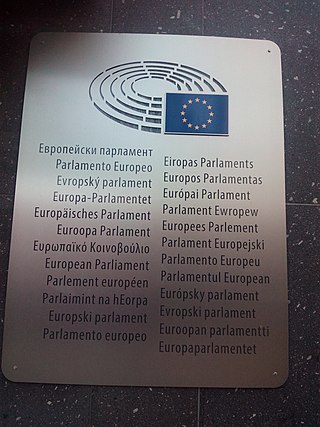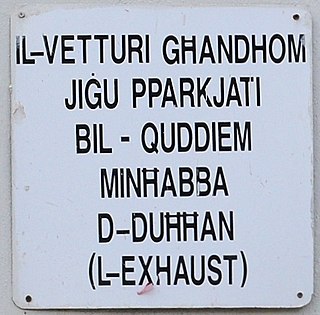
The European Union (EU) is a supranational political and economic union of 27 member states that are located primarily in Europe. The union has a total area of 4,233,255 km2 (1,634,469 sq mi) and an estimated total population of over 448 million. The EU has often been described as a sui generis political entity combining the characteristics of both a federation and a confederation.

The European Union (EU) has 24 official languages, of which three – English, French and German – have the higher status of "procedural" languages of the European Commission. Irish previously had the lower status of "treaty language" before being upgraded to an official and working language in 2007. However, a temporary derogation was enforced until 1 January 2022. The three procedural languages are those used in the day-to-day workings of the institutions of the EU. The designation of Irish as a "treaty language" meant that only the treaties of the European Union were translated into Irish, whereas Legal Acts of the European Union adopted under the treaties did not have to be. Luxembourgish and Turkish, which have official status in Luxembourg and Cyprus, respectively, are the only two official languages of EU member states that are not official languages of the EU. In 2023, the Spanish government requested that its co-official languages Catalan, Basque, and Galician be added to the official languages of the EU.

Multilingualism is the use of more than one language, either by an individual speaker or by a group of speakers. It is believed that multilingual speakers outnumber monolingual speakers in the world's population. More than half of all Europeans claim to speak at least one language other than their mother tongue; but many read and write in one language. Multilingualism is advantageous for people wanting to participate in trade, globalization and cultural openness. Owing to the ease of access to information facilitated by the Internet, individuals' exposure to multiple languages has become increasingly possible. People who speak several languages are also called polyglots.

European Union culture policies aim to address and promote the cultural dimension of European integration through relevant legislation and government funding. These policies support the development of cultural activity, education or research conducted by private companies, NGO's and individual initiatives based in the EU working in the fields of cinema and audiovisual, publishing, music and crafts.
In varietate concordia is the official motto of the European Union (EU), adopted in 2000. Its translations in the other 24 official languages of the EU have equal standing. It is inspired by its Latin-language version coined by the Italian Nobel prize winner Ernesto Teodoro Moneta: In varietate concordia or In varietate unitas, which is also used as a compromise. It is one of the newest symbols of the European Union, alongside the European flag and anthem but, unlike most, it is specific to the EU rather than originating from the Council of Europe.
In the European Union education is at the responsibility of its Member States and their Ministries of education that they have; in such, the European Union institutions play only a supporting and overseeing role. According to Art. 165 of the Treaty on the Functioning of the European Union, the Community
shall contribute to the development of quality education by encouraging cooperation between Member States, through actions such as promoting the mobility of citizens, designing joint study programmes, establishing networks, exchanging information or teaching languages of the European Union. The Treaty also contains a commitment to promote life-long learning for all citizens of the Union.

Leonard Orban is a Romanian independent technocrat who served as the Commissioner for Multilingualism in the European Commission, the executive body of the European Union (EU). He was responsible for the EU language policy and was the first Romanian Commissioner and the first member of the Commission whose portfolio is exclusively multilingualism. His term of office began on 1 January 2007 and ended on 9 February 2010. With a background in engineering and economics, Orban has taken up various posts working for the accession of Romania to the European Union, most prominently as Deputy and later as Chief Negotiator for his country at the time of final negotiations with the European Union.

Armenia is located in the Caucasus region of south-eastern Europe. Armenian is the official language in Armenia and is spoken as a first language by the majority of its population. Armenian is a pluricentric language with two modern standardized forms: Eastern Armenian and Western Armenian. Armenia's constitution does not specify the linguistic standard. In practice, the Eastern Armenian language dominates government, business, and everyday life in Armenia.

Malta has two official languages: Maltese and English. Maltese is the national language. Until 1934, Italian was also an official language in Malta, and in the 19th and 20th centuries there was a linguistic and political debate known as the Language Question about the roles of these three languages. The Maltese population is generally able to converse in languages which are not native to the country, particularly English and Italian. They can also somewhat understand Darija.
Intercultural dialogue has long been a principle supported by the European Union and its Institutions. The year 2008 was designated "European Year of Intercultural Dialogue" (EYID) by the European Parliament and the Member States of the European Union. It aimed to draw the attention of people in Europe to the importance of dialogue within diversity and between diverse cultures.
The STELLA project was originally supported and co-funded by the European Commission. The aim was to develop a new language learning methodology for online language learning suitable for European learners. The project's aim was also to deliver online language learning courses for less widely taught and used languages (LWTULs) within the European Union in order to meet the European Union's aim to "safeguard the linguistic diversity in Europe". The methodology was subsequently used in courses which further delivered languages considered to be of strategic importance to the EU and member states.

The languages of Turkey, apart from the official language Turkish, include the widespread Kurdish (Kurmanji) and Arabic, and a number of less common minority languages. Four minority languages are officially recognized in the Republic of Turkey by the 1923 Treaty of Lausanne and the Turkey-Bulgaria Friendship Treaty of 18 October 1925: Armenian, Bulgarian, Greek, and Hebrew. In 2013, the Ankara 13th Circuit Administrative Court ruled that the minority provisions of the Lausanne Treaty should also apply to Assyrians in Turkey and the Syriac language.

Immigration to Europe has a long history, but increased substantially after World War II. Western European countries, especially, saw high growth in immigration post 1945, and many European nations today have sizeable immigrant populations, both of European and non-European origin. In contemporary globalization, migrations to Europe have accelerated in speed and scale. Over the last decades, there has been an increase in negative attitudes towards immigration, and many studies have emphasized marked differences in the strength of anti-immigrant attitudes among European countries.
Human rights in Estonia are acknowledgedas being generally respected by the government. Nevertheless, there are concerns in some areas, such as detention conditions, excessive police use of force, and child abuse. Estonia has been classified as a flawed democracy, with moderate privacy and human development in Europe. Individuals are guaranteed on paper the basic rights under the constitution, legislative acts, and treaties relating to human rights ratified by the Estonian government. As of 2023, Estonia was ranked 8th in the world by press freedoms.

CIFE - the Centre international de formation européenne is a not-for-profit European institution of higher education and research established in 1954. CIFE encompasses educational and research activities promoting European integration and governance, multilingualism and student mobility. CIFE educates European and international students as future Policy Officers in European institutions and international organisations, a professional title which is recognised by the French state.
The official languages of the United Nations are the six languages used in United Nations (UN) meetings and in which the UN writes all its official documents.
Practices in language education vary significantly by region. Firstly, the languages being learned differ; in the United States, Spanish is the most popular language to be learned, whereas the most popular languages to be learned in Australia are German, French, Italian and Mandarin Chinese. Also, teaching methods tend to differ by region. Language immersion is popular in some European countries, and not used very much in the United States.

The linguistic landscape refers to the "visibility and salience of languages on public and commercial signs in a given territory or region". Linguistic landscape research has been described as being "somewhere at the junction of sociolinguistics, sociology, social psychology, geography, and media studies". It is a concept which originated in sociolinguistics and language policy as scholars studied how languages are visually displayed and hierarchised in multilingual societies, from large metropolitan centers to Amazonia. For example, linguistic landscape scholars have described how and why some public signs in Jerusalem are presented in Hebrew, English, and Arabic, or a combination thereof. It also looks as how communication in public space plays a crucial role in the organisation of society.
EUF - Campus Europae is a European network which aims at the promotion of high quality student mobility and contributing to educating a generation of European graduates with an innate understanding of Europe’s unity in diversity. The project is under the patronage of the Government of the Grand Duchy of Luxembourg and its secretariat is in Oetrange.
The following is a list of bilingual education by country or region.










